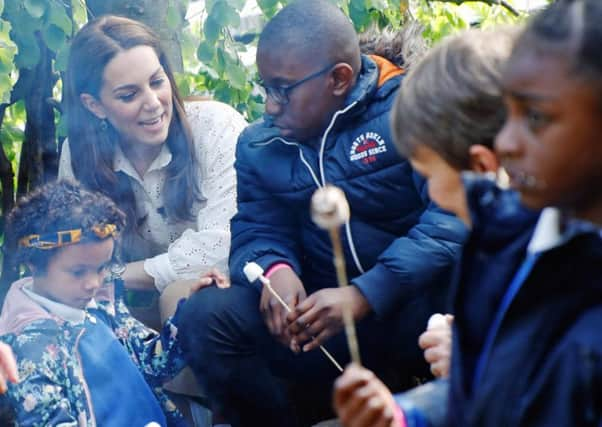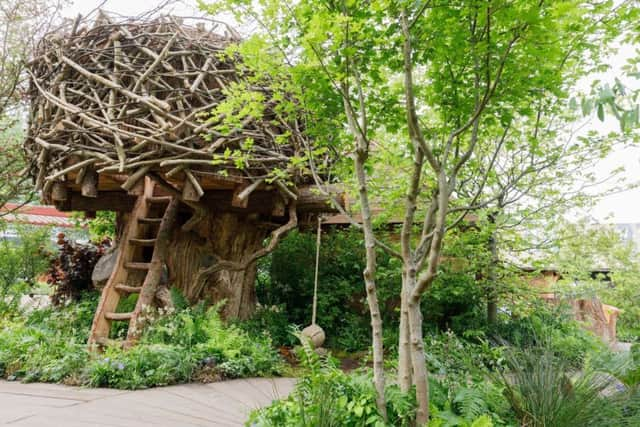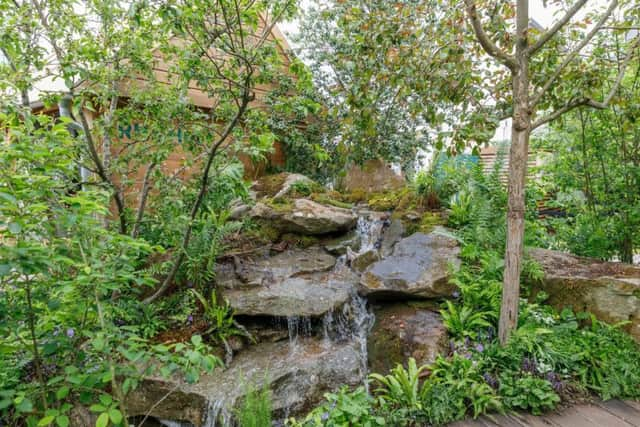Duchess goes back to nature at Chelsea show
This article contains affiliate links. We may earn a small commission on items purchased through this article, but that does not affect our editorial judgement.


It has families and childhood memories at the heart of its design, co-designed with Andree Davies and Adam White of Davis White Landscape Architects.
The show garden wasn’t judged, and key elements include a hollow log for children to climb through, a den, waterfall, stream and tree house.


Advertisement
Hide AdAdvertisement
Hide AdThe tree house forms the centrepiece of the garden, with a swing seat hanging from the branches. The waterfall and stream encourage play, from floating Pooh sticks to making dams to attract more wildlife.
Wild trees and shrubs combined with a cool, calm colour palette of green and blue provide an instant ‘nature fix’ to relax and calm, while the playful and diverse planting includes edibles such as wild strawberries and plants for craft activities and forest scents.
The flowers, fruits and seeds provide food for wildlife and nectar for bees and butterflies, while the plants offer nesting sites and shelter for birds and other animals.
Sue Biggs, RHS Director General, said: “We couldn’t be happier with the wonderful design by The Duchess of Cambridge and Andree and Adam for our garden at Chelsea this year.


Advertisement
Hide AdAdvertisement
Hide Ad“The RHS’s Garden is a beautiful natural space for families to get together, play, dig, grow plants, connect with nature and spend time in the great outdoors – something core to us as a charity to promote, inspire and encourage people to do.”
The RHS Back to Nature Garden is part of a partnership with NHS England, which promotes the physical and emotional wellbeing that access to green spaces and gardening provides.
After Chelsea, some of the planting and landscaping will go to the Devon Partnership NHS Mental Health Trust, as winners of a national competition.
The former Kate Middleton has also collaborated with the RHS to publish five activity guides to inspire young gardeners and hopefully add a touch of Chelsea magic to their own homes.
Advertisement
Hide AdAdvertisement
Hide AdThe step-by-step guides to creating fairy gardens, welly planters, leaf wands, a bug hotel and painted pebbles take inspiration from the Back to Nature Garden, visit https://schoolgardening.rhs.org.uk/Resources/Info-Sheet/Back-to-Nature-Activity-CardsGET IN TOUCH
l For more information, plus cook what you grow, recipes, environmental news and more, log on to the website at www.mandycanudigit.com – which is also now smartphone friendly.
You can also follow Mandy on social media platforms – on Twitter @MandyCanUDigIt or you can like her on her Facebook page at Mandycanudigit
JOBS TO DO THIS WEEKEND
Sweet peas need training and tying into their supports to encourage them to climb and make a good display.
Advertisement
Hide AdAdvertisement
Hide AdHoe borders to prevent annual and perennial weeds from spreading and seeding themselves.
Liquid feed plants in containers every two to four weeks.
Aphids can multiply rapidly. Remove early infestations by hand to prevent the problem getting out of hand. Protect sweet pea plants in particular, as they can get sweet pea viruses.
Continue to protect lily, delphinium, hosta, and other susceptible plants from slugs and snails.
Prune spring-flowering shrubs such as Japanese quince (Chaenomeles), Choisya and Ribes after flowering. Remove one stem in three from Kerria and Spiraea ‘Arguta’, and shorten the other flowered stems to a suitable side shoot.
Advertisement
Hide AdAdvertisement
Hide AdPrune wall-trained Pyracantha, removing shoots coming from the wall, and shortening other new growth to about 8cm (3in). This encourages spur formation and increases flowering.
Remove blanket weed in ponds by twirling around a rough stick. Skim off floating weeds such as duckweed with a net. Leave weeds on the pond side for 24 hours to allow trapped creatures to return to the water.
Evergreens such as Viburnum tinus can also still be trimmed.